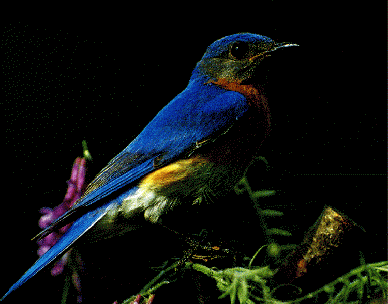
Hatching Patterns in Birds: Testing a Critical Assumption
Anne Ford, Mark Stanback, and Katie Lannon
Department of Biology, Davidson College
Abstract
Researchers have traditionally defined hatching
asynchrony with respect to the difference in size between the largest and
smallest chicks in the brood. However, this definition ignores the potential
influence of the other chicks in the brood. To test the validity of this
definition, and thus the validity of experiments in which asynchrony is
artificially exaggerated, we manipulated Eastern Bluebird (Sialia sialis)
broods into two distinct patterns (multiple runt and single runt) with identical
total asynchrony. Treatment type did not affect the growth of either "large"
or "small" chicks. Although our results tentatively validate assumptions
and techniques of previous experiments, larger sample sizes are necessary
to provide a critical test.
Introduction
Depending on when they initiate incubation during
egg laying, birds can produce hatching patterns that vary from complete
synchrony to extreme asynchrony. Because hatching asynchrony often results
in brood reduction (stravation of the later-hatched chicks), various hypotheses
have been proposed to explain the evolution and maintenance of different
hatching patterns. To compare the adaptiveness of these alternative strategies,
workers often examine chick growth in broods manipulated to be either synchronous
or asynchronous. In such experiments, "asynchrony" is usually
defined with respect to the size of the largest and smallest chick, without
regard for the relative sizes of the other chicks in the brood. To test
the validity of this practice, we compared the condition of large and small
chicks, respectively, in broods containing single vs. multiple runts.
Methods
Manipulated Eastern Bluebirds broods into two patterns: Multiple Runt (MR)
and Single Runt (SR)
Measured chicks every other day for nine days
Paired each Multiple Runt brood with a Single Runt brood based on date of
manipulation
Compared chick size in the paired broods using a paired t-test
Artificially Created Hatching Patterns. A newly hatched chick was switched with a 2 day-old chick, resulting in a total age difference of approximately 48 hours in both broods.
Runts in paired SR and MR brood did not differ significantly in size. We compared single runt size to the mean size of the multiple runts. Error bars represent 95% confidence intervals, n=6 paired broods, paired t-test.
Large chicks in paired SR and MR brood did not differ significantly in size, despite a trend for average large chick body size in SR broods to be greater than that of single large chicks in MR broods. Error bars represent 95% confidence intervals, n=6 paired broods, paired t-test.
Conclusions
Chicks of equivalent size raised in broods with different size hierarchies
did not differ significantly in their growth
Findings tentatively validate the use of relative size differences between
the largest and smallest chicks as a measure of hatching asynchrony
An increase in sample size planned for 1998 should clarify these results
Acknowledgements: Thanks to Dawn Houseton and Janet Beamer for assistance
and to the Howard Hughes Medical Institute for financial support.
This experiment was conducted as a summer undergraduate research project.
© Copyright 2000 Department of Biology, Davidson
College, Davidson, NC 28036
Send comments, questions, and suggestions to: mastanback@davidson.edu